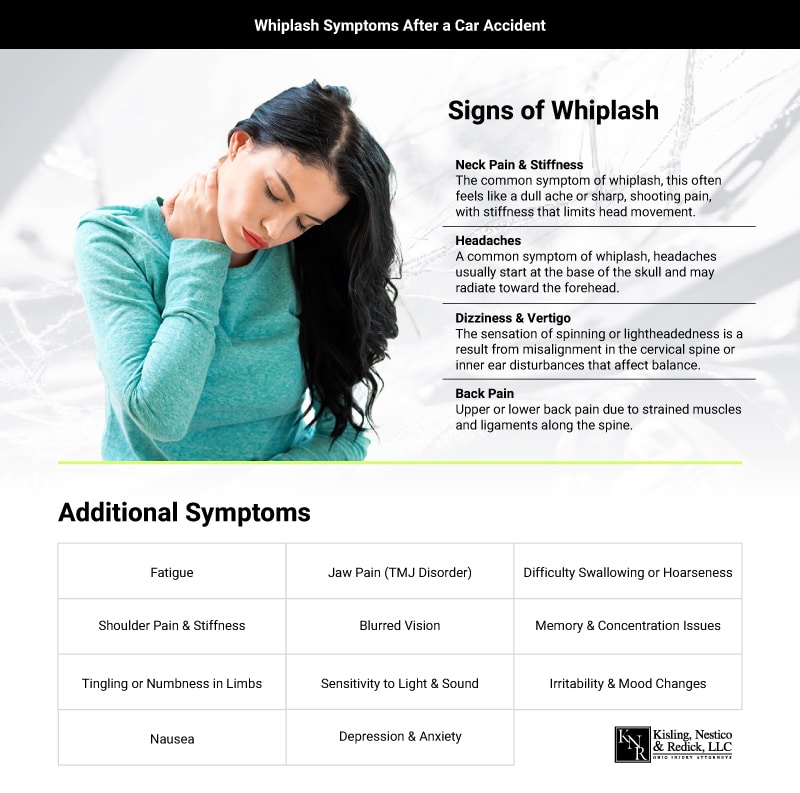Avoid Settlement Mills by Working with a Real Personal Injury Lawyer
Posted in: Car Accidents

KNR Legal Blog
If you’ve been injured in a car crash that wasn’t your fault, it’s critical to understand the symptoms of whiplash and know what steps to take next. At Kisling, Nestico & Redick, our Ohio car accident attorneys are here to help.
Call us today at 1-800-HURT-NOW for a free consultation. We’ll discuss your injuries, options, and next steps. We only get paid when you recover compensation.
Whiplash is a neck injury that occurs when the head is suddenly jerked back and forth, like during a car crash. This motion can strain or tear the neck’s muscles, tendons, and ligaments, leading to pain that may not appear immediately. Whiplash symptoms are often delayed due to adrenaline and cortisol surges that temporarily mask the pain.
Whiplash commonly occurs in rear-end collisions, as the impact causes occupants to lurch forward while seatbelts hold their bodies in place, putting stress on the neck. This injury can happen at any speed, though higher speeds increase the risk of severe damage.
If you’re in a car accident—even a low-speed one—seeing a doctor immediately is essential. An early medical evaluation can diagnose whiplash, helping you avoid complications and creating documentation for any injury claims.
Whiplash injuries can lead to financial burdens and prolonged suffering. If another driver’s negligence caused your injury, you may be entitled to compensation. KNR can assist you with determining liability, building your case, and negotiating with insurance companies to ensure you’re fully and compensated.

Whiplash symptoms can vary greatly, with some people experiencing only mild discomfort while others face more severe, even debilitating pain.
The hallmark symptom of whiplash, this often feels like a dull ache or sharp, shooting pain, accompanied by stiffness that limits head movement. This occurs because the rapid back-and-forth motion during a car accident can strain or tear the muscles and ligaments in the neck.
A common symptom of whiplash, headaches usually start at the base of the skull and may radiate toward the forehead. They are often caused by irritation to nerves around the brain stem due to the force exerted on the neck.
This sensation of spinning or lightheadedness typically worsens with head movement and results from misalignment in the cervical spine or inner ear disturbances that affect balance.
Persistent tiredness is often reported with whiplash, even after a full night’s sleep, as the body works hard to heal and manage pain caused by the injury.
While whiplash primarily affects the neck, the impact can also cause upper or lower back pain due to strained muscles and ligaments along the spine.
Shoulder pain commonly accompanies neck pain in whiplash injuries, often resulting in stiffness that limits arm movement. This is due to stress on shoulder muscles and tendons during the accident.
Known as cervical radiculopathy, this sensation of tingling, numbness, or weakness in the arms, hands, or fingers occurs when spinal nerves are compressed or irritated.
Jaw pain can result from whiplash as the sudden force may strain the temporomandibular joint (TMJ), causing discomfort, clicking, or difficulty chewing.
Blurred or double vision is a less common symptom, likely due to strain on nerves associated with eye movement from neck muscle tension.
Sensitivity to bright lights and loud sounds may occur, similar to migraines, due to the effects of whiplash on areas of the brain involved in sensory processing.
Some whiplash sufferers experience trouble swallowing or a hoarse voice due to the strain or pressure on the throat muscles and nerves from the impact.
Often called “brain fog,” these symptoms may include trouble focusing or remembering details, resulting from minor traumatic brain injury associated with whiplash.
Mood changes, including irritability, sadness, or mood swings, are common due to physical discomfort, stress, and possible brain trauma.
Feelings of nausea, especially when moving the head, can be triggered by balance disturbances from cervical vertigo or inner ear issues related to whiplash.
Chronic pain and lifestyle disruptions from whiplash can contribute to or worsen mental health symptoms like depression or anxiety, especially if recovery is prolonged.
If you visit a doctor after a car accident, they will typically conduct a thorough physical examination, asking about your symptoms and testing your range of motion and muscle strength. Imaging tests such as X-rays, MRIs, or CT scans may also be ordered to assess potential damage to the neck’s soft tissues and rule out more serious injuries.
In addition to medical doctors, chiropractors are often consulted for whiplash injuries. Chiropractors can provide adjustments and spinal manipulations to relieve pressure on the neck, promote healing, and restore mobility. They may also recommend complementary therapies, such as specific exercises and lifestyle adjustments, to help support long-term recovery.
Each case of whiplash is unique, so a doctor may recommend a personalized combination of treatments based on the severity of your symptoms. Here are some common treatment approaches:
Effective treatment can alleviate symptoms, but some whiplash cases may require longer-term care to fully resolve. If your symptoms persist, additional therapies may be needed, and it’s essential to follow your doctor’s advice for the best recovery outcomes.
Most whiplash injuries heal within a few weeks or months, but some individuals experience persistent pain or chronic whiplash. If your symptoms last six months or longer, it’s essential to seek specialized treatment and consider a legal consultation to explore compensation options for prolonged recovery costs.
Whiplash injuries can interrupt your life, causing physical pain, emotional distress, and financial hardship. At KNR, our Ohio car accident lawyers are experienced in handling cases like yours, guiding you through the process to hold the responsible party accountable.
With KNR, you can focus on recovery while we:
Whiplash injuries can lead to costly medical bills, lost income, and ongoing physical pain, affecting your quality of life long after the accident. At Kisling, Nestico & Redick, our experienced Ohio car accident attorneys are here to help you understand your rights and options for seeking compensation.
If you or a loved one suffered a whiplash injury in an Ohio car accident, contact KNR for a free, no-obligation consultation to discuss your case, learn about your legal options, and take the first step toward recovery. Call 1-800-HURT-NOW or complete this form for a free, no-obligation consultation to discuss your case and options. With KNR, you only pay if we recover compensation for you.